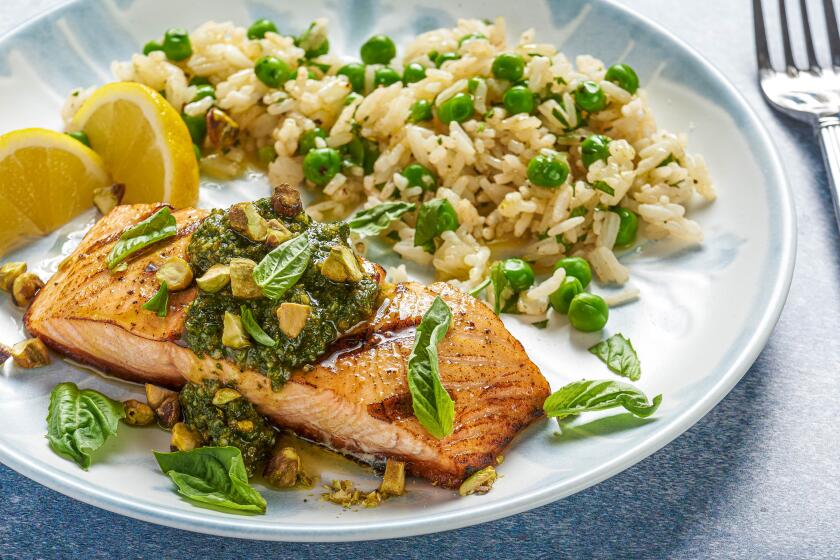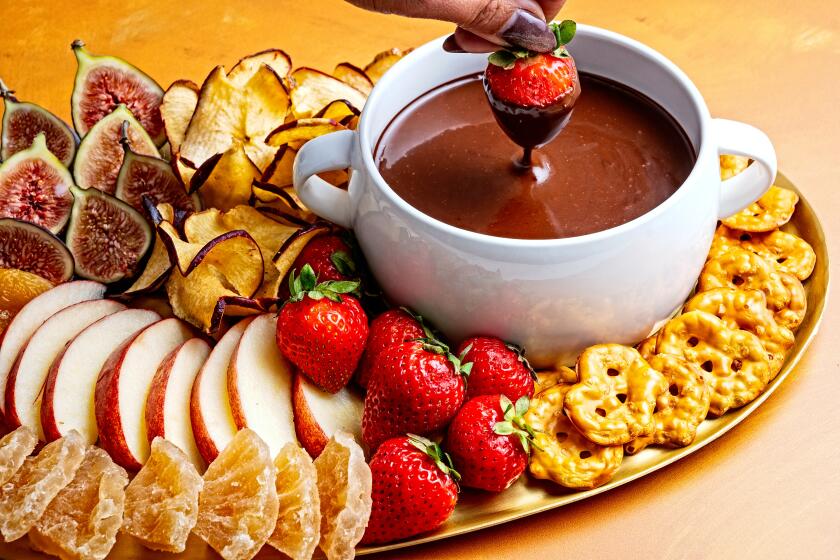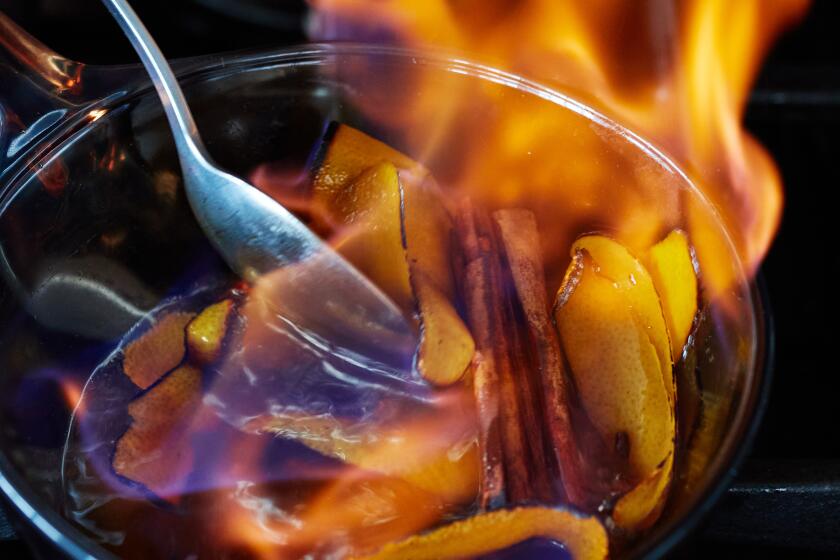Ease February’s chill with 3 comforting soups from chef Claudia Sandoval

San Diegans know we have it pretty easy compared with other parts of the country when it comes to the mayhem of winter weather. Still, chilly is chilly, and there’s nothing as comforting for lunch or dinner when the temps are well below balmy than a bowl of soup. And a family soup you learned to make from your mother or grandmother? Well, those flavors and aromas can take you straight back to childhood.
That’s what it does to San Diego/Tijuana-area baker and chef Claudia Sandoval. Sandoval, of “MasterChef” fame, is the author of “Claudia’s Cocina: A Taste of Mexico” and is working on a new cookbook while also serving as the culinary director of this year’s Culinary Concerto — Mainly Mozart Gala Soiree, in March. She was taught how to cook by her mom and grandmother. It wasn’t soup they started her with, however, but sorting beans, when she was around age 3.
She progressed to making tortillas — “my first tortilla was shaped like Africa,” she said with a laugh — and then roasting chiles to make salsas. By the time Sandoval was 8 or 9, she was cooking full meals for herself and her brother.
The food Sandoval creates reflects her family roots in the Sinaloa city of Mazatlán, a coastal region rich in agriculture and, of course, seafood. While her family’s land produces avocados, poblano, guajillo and jalapeño peppers, she emphasized that Mazatlán is very seafood-forward. And there were, and are, a lot of soups.
Sandoval doesn’t consider herself a recipe developer, but more an interpreter of the dishes she grew up with.
“I think a lot of what I do is use the same ingredients and same recipes, while finding better ways to present them because it’s not that our food isn’t good — it’s just undervalued because it’s not presented beautifully,” she explained. “I find ways to present it in such a way that somebody’s going to give it value. Our food is culture-rich. It has years and years of incredible heritage and culture and technique. Every detail has to be paid attention to.”
There are also foods, like the soup recipes she’s shared here, that are deeply meaningful to her that are also simple. They come with the caveat that there’s still a lot of unstated technique that helps accomplish results that take her back to memories of her grandmother’s kitchen. These are the things that aren’t explicitly written into a recipe, but what you learn by watching.
“My grandmother isn’t telling me that when the pot starts to boil over, just give it half of a tilt so that it releases some of the steam but still continues to boil,” Sandoval said. “She just did it and I learned. All of those little types of technique aren’t things I can write into a recipe, because it won’t make sense unless it’s happening at the moment. But these recipes are important because they’re an homage to my grandmothers and their immigrant story.
“It’s like I have now built a whole career on their recipes, if you think about it. And they were right. There’s nothing more valuable than what they shared.”

What may be the easiest recipe is Sandoval’s bright Potato and Queso Fresco Soup that’s made with onion, tomatoes, Mexican oregano, garlic, peppercorns, potatoes and queso fresco. They are simple ingredients, but Sandoval’s technique extracts every bit of flavor from each to create a cozy, complex tasting soup. You probably have everything but the cheese in your kitchen already. Queso fresco (or fresh cheese) is a mild, soft, tangy cow’s milk cheese from Mexico. The best place to find a good queso fresco is at one of San Diego’s many Mexican markets, or mercados. Instead of buying packaged cheese, go to the dairy counter of a store like Northgate where they have large fresh rounds they can cut for you, said Sandoval.
As for the potatoes, any kind will do. As they cook and break down, they help thicken the soup. But do be particular about the oregano. You can find Mexican oregano at mercados as well. The flavor is bolder and more floral than Mediterranean oreganos. For a soup with as few ingredients as this one, it will make a difference in the soup’s punch.
Essentially, you’ll saute chopped onions in a large stockpot, then add chopped Roma tomatoes and, once they begin to sweat, add the dried oregano by crushing the leaves between your palms to release the oils and add to the pot. While that’s happening, you’ll grind together the garlic cloves and peppercorns in a molcajete, if you have one. And you should: They’re the Mexican version of a mortar and pestle, carved from natural volcanic stone, which gives the bowl a slightly rough interior. Use it to grind spices, chiles, nuts and seeds, but also to prepare salsas and guacamole. I have one and even use it to make vinaigrettes, mashing the garlic to a paste with salt before adding the rest of the ingredients.
Here you create a paste with the garlic and peppercorns, then loosen it up with a bit of water before adding to the stockpot. From there, add the remaining water and season with salt before adding the potatoes. Once the potatoes are fork-tender, add the queso fresco and remove from heat. Give it 10 minutes to rest and the cheese will have melted over the soup. Serve the soup with tortillas. It’s also easy to reheat the next day.
Sandoval’s Short Rib and Bean Soup is a hearty meal perfect for a stormy evening. The trick to this soup is to have a butcher chop the beef ribs into smaller pieces, Sandoval said. And don’t discard the bones once the soup is cooked; this is a rustic soup and one of the pleasures of it is pulling a bone out of the bowl and eating the meat from it.
“In Mexico, we have all the bones in there,” she explained. “You suck on the bones and put the empty ones on your plate. It’s like cioppino. You wouldn’t serve it with the clam shells removed, right? It’s the same kind of thing.”
Because this is a short rib dish, it’s going to take hours to cook. But it’s pretty much hands-off once all the ingredients are in the pot. There’s an onion — but all it needs is to be peeled — along with a head of garlic that is halved horizontally, black peppercorns and a couple of Morita chiles. If you’re not familiar with them, they are dried and smoked jalapeños that go into making chipotles in adobo sauce. They’re a bit spicy but have a sweet, smoky, almost chocolatey aroma and flavor. If you can’t take a little heat, Sandoval said they can be left out, but the chile has such a specific flavor, it can’t really be substituted with another type of chile. All these ingredients will be brought to a boil, covered and boiled for two to three hours until the meat begins to separate from the bones. Skim the foam from the top within the first 20 to 30 minutes.

Once the meat is cooked, remove the garlic and onion, season with kosher salt and add the beans. Bring the pot back to the boil and cook another hour until the beans are soft. At that point, you can take the pot from the heat and spread cilantro (stems and all) across the top of the soup. Then cover and let the soup rest and the cilantro infuse into the soup for about 10 minutes. When you serve it, top each bowl with a mixture of chopped cilantro and scallions and serve with tortillas.
Finally, here’s a soup that requires just a bit of finesse — making shrimp balls, known as albondigas, and they’re dreamy. For this Shrimp Albondigas Soup, you’ll clean the shrimp of their heads and shells. Then puree garlic, green onion and shrimp in a food processor. Refrigerate the paste until it’s time to add them to the soup.
Then make a stock with onion, garlic, celery, green bell pepper, carrot, Mexican oregano, peppercorns and water, along with the heads and shells of Mexican shrimp you’ve cleaned from the fresh shrimp. Once the stock is made, strain it, then add chopped green bell pepper, chopped carrots and cubed potatoes to give it more flavor and texture. Simmer until the potatoes are tender.
Now it’s time to make the albondigas. Be sure to spread some vegetable oil on your hands so the shrimp won’t stick while you roll 1 to 2 ounces of the shrimp paste into a ball. Add each one to the simmering soup as you make them until you’ve used up all the shrimp paste. Simmer for 5 minutes and serve with tortillas.

Potato and Queso Fresco Soup
Makes 3½ quarts
INGREDIENTS
- ¼ cup vegetable oil
- ½ white onion, chopped
- 2 cups Roma tomatoes, chopped
- 2 tablespoons dried Mexican oregano
- 2 garlic cloves
- 6 whole peppercorns
- 4 liters of water/stock of choice
- Kosher salt to taste
- 1 to 1.5 pounds potatoes of choice, cubed
- 1 pound queso fresco, cubed
DIRECTIONS
1. Set a large stockpot over low heat and add oil and onions. Saute for 1 to 2 minutes or until aromatic and translucent. Add tomatoes and mix to combine. When tomatoes begin to sweat red and break down, add oregano by crushing between palms and rubbing back and forth. Mix and stir until aromatic, about 1 to 2 minutes.
2. Meanwhile, in a molcajete or mortar and pestle, grind garlic and peppercorns into a smooth paste. Add ½ cup of water/stock to rinse molcajete and add to pot. Mix in until aromatic. Add remaining water/stock. Season with salt to taste.
3. Add potatoes and cover to bring to a boil. Reduce heat to simmer and simmer for 15 to 20 minutes or until potatoes are soft and fork-tender. Add queso fresco. Remove from heat and allow to rest for 10 minutes.
4. Serve with tortillas of your choice.
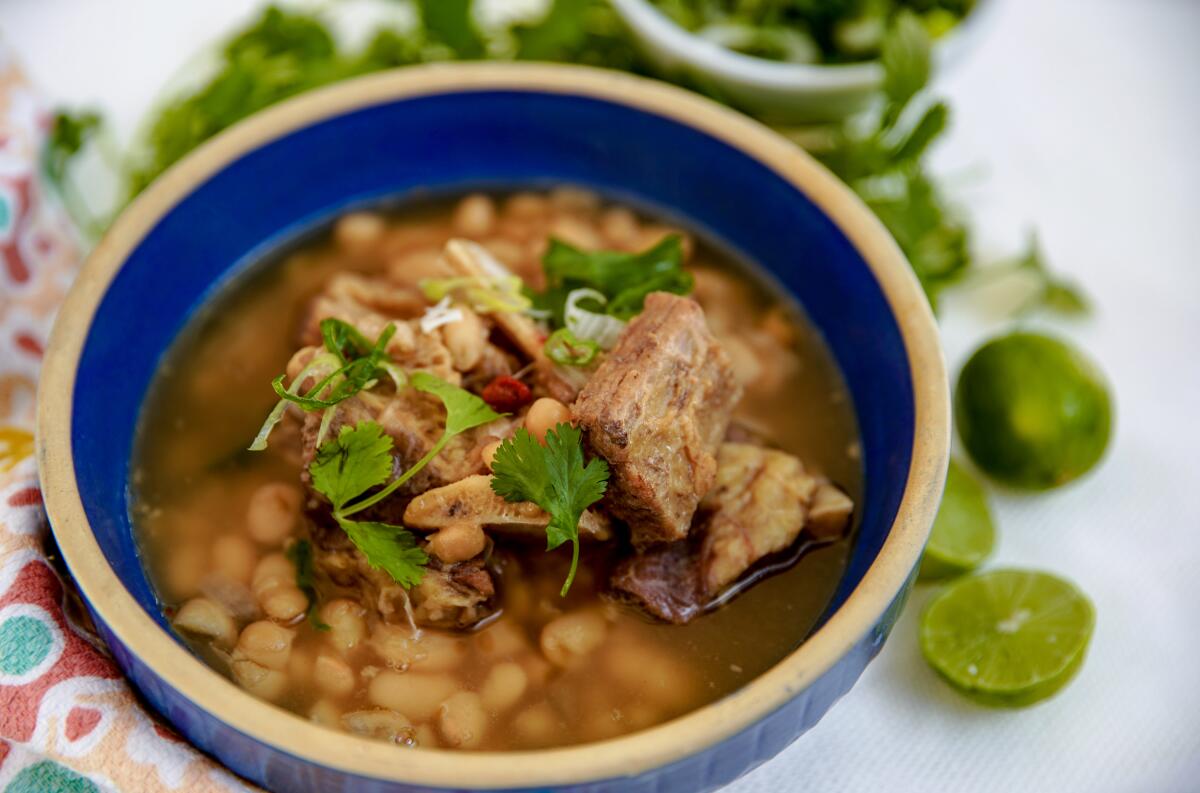
Short Rib and Bean Soup
Makes 6 quarts
INGREDIENTS
- 5 pounds beef short ribs, bone-in
- 1 yellow onion, peeled
- 1 head garlic halved horizontally
- 12 whole black peppercorns
- 1 to 2 Morita chiles
- 1.5 pounds dried Peruvian beans
- Kosher salt to taste
- 1 bunch of cilantro, rinsed
FOR THE TOPPING:
- 1 cup chopped cilantro
- 1 cup chopped scallions/red onions
DIRECTIONS
1. Set a large stockpot over medium heat. Add short ribs and cover with enough water to cover over 4 inches above ribs. Add onion, garlic, black peppercorns and Morita chiles to pot and cover. Boil for 2 to 3 hours, skimming often within the first 20 to 30 minutes and removing any impurities from broth. Boil until meat begins to separate from the bones and the beef is starting to get soft. Remove onion and garlic heads. Season with kosher salt to taste.
2. Meanwhile, sort and rinse beans thoroughly, removing any broken, deshelled or imperfect beans. Add beans to pot. Boil until beans are soft and tender, about 1 more hour.
3. Turn off heat and spread the bunch of cilantro on the top of the soup. Cover and allow to rest for 10 to 15 minutes before serving. This will infuse the cilantro’s flavor into the soup.
4. Serve and top with chopped cilantro and scallions and enjoy with tortillas of your choice.
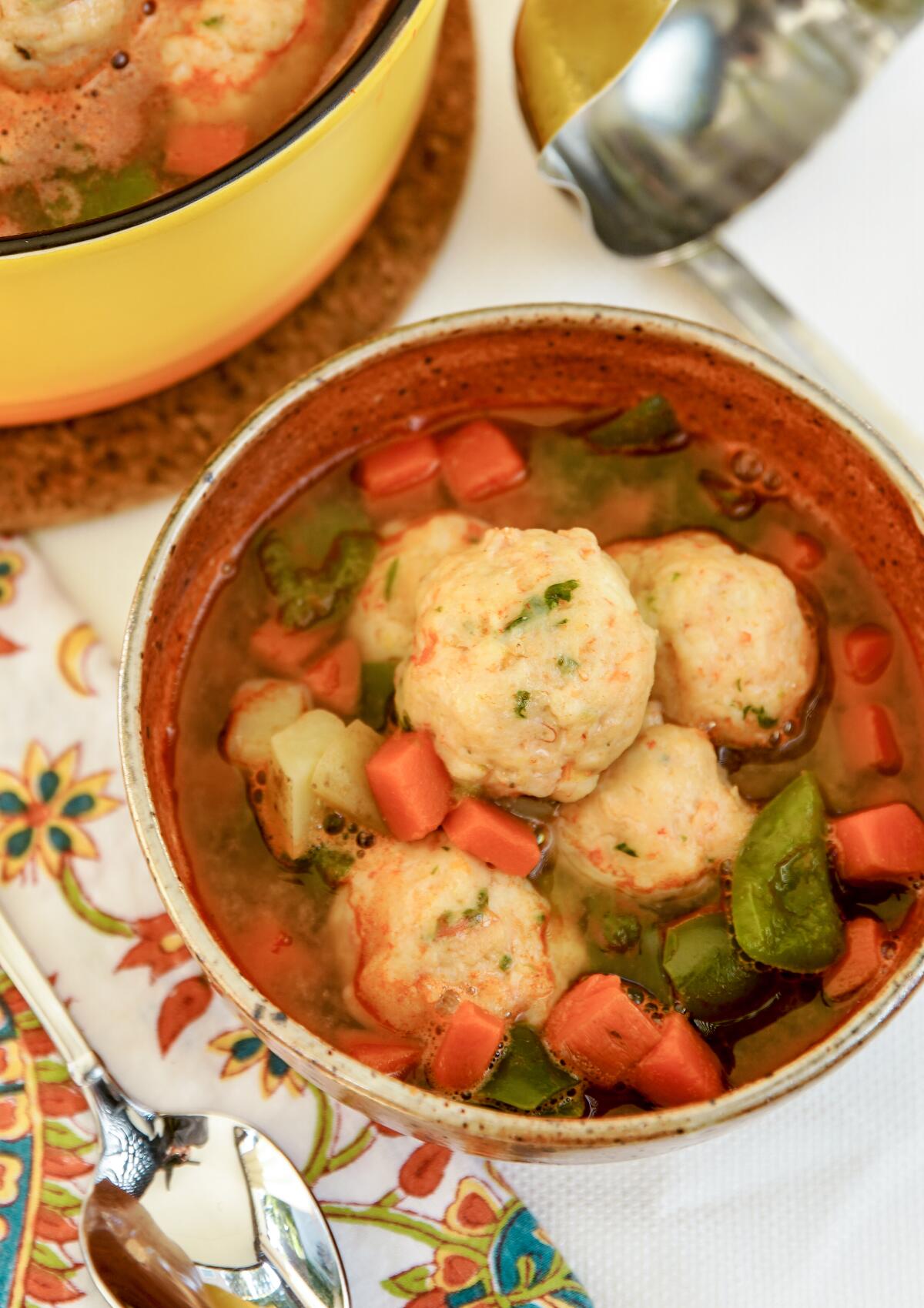
Shrimp Albondigas Soup
Makes 3½ quarts
INGREDIENTS
FOR ALBONDIGAS:
- 3 pounds Mexican shrimp, heads on
- 2 garlic cloves, minced
- 2 green onions, minced
FOR SOUP BASE:
- ¼ cup vegetable oil, plus more for hands
- 1 medium yellow onion, diced
- 2 garlic cloves, sliced
- 1½ cups celery, chopped
- 1½ cups green bell pepper, chopped
- 1½ cups carrot, chopped
- 2 tablespoons whole dried Mexican oregano
- 10 whole black peppercorns
- 4¼ quarts hot water
- Kosher salt to taste
FOR FINAL SOUP:
- 1 cup green bell pepper, chopped
- 1 cup carrot, chopped
- 1 pound potatoes, cubed
DIRECTIONS
1. Peel and devein shrimp. Reserve all heads and shells.
2. In a large food processor add garlic cloves and green onions. Process until finely chopped. Add shrimp meat and process until a chunky paste is developed. Refrigerate until ready to use. If you do not have a food processor chop until a chunky paste is created.
3. Set a stock pot over medium-high heat and add oil, onions, garlic, celery, bell pepper, and carrots. Saute for 2 minutes. Add shrimp heads and shells and saute for an additional 2 minutes. Add oregano and peppercorns and saute for 1 to 2 minutes or until aromatic. Add hot water and bring to a rolling boil. Season with kosher salt to taste. Reduce heat and simmer on low for 20 minutes. Strain soup base through a fine mesh sieve.
4. Add potatoes, bell pepper, and carrots and simmer covered for 15 minutes or until potatoes are fork-tender.
5. Retrieve the shrimp paste from the refrigerator. Spread vegetable oil on your hands, then scoop 1 to 2 ounces of the shrimp paste and roll into meatballs (greasing hands as needed to prevent sticking). Add each meatball to the simmering broth. Repeat until all shrimp paste is done. Simmer for 5 minutes and remove from heat.
6. Serve with tortillas of your choice.
Recipes by chef Claudia Sandoval.
Golden is a San Diego freelance food writer and blogger.
Get Essential San Diego, weekday mornings
Get top headlines from the Union-Tribune in your inbox weekday mornings, including top news, local, sports, business, entertainment and opinion.
You may occasionally receive promotional content from the San Diego Union-Tribune.

